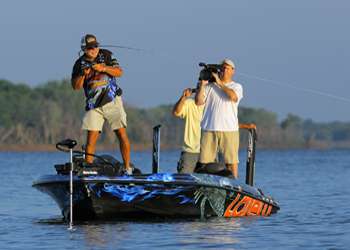
Banging his namesake lure across the bottom of Fort Gibson Lake produced a victory for Tommy Biffle at the AutoZone Sooner Run Elite Series event in June.
Two weeks later, the 2011 Bassmaster Classic qualifier won a tournament at Cherokee Lake, flipping his Gene Larew Biffle Bug to bushes. Biffle’s back-to-back victories exemplify the versatility and effectiveness of the creature bait he invented. “It has a hollow body and the tail is concave so it’s real limber and thin which gives it a lot of action,” says Biffle. “It also has swimming legs which gives it good action when using it on the (Gene Larew) Hardhead jig and when you’re flipping and pitching it.
Since it’s hollow, you can put a rattle and scent in it or foam ear plugs to make it float on a Carolina rig. You can also throw it without a weight in grass and run it across the top like a frog.”
His winning setup at Fort Gibson consisted of a Biffle Bug in the Sooner Run hue (a dark green color) attached to the new Biffle Hardhead, a football-head weight with a swinging worm hook that allows the lure to move freely as it bounces along the bottom.
The Oklahoma pro varied the sizes of the Hardhead (5/16-, 7/16- and 9/16-ounce) and steadily cranked his jig-and-creature combo along rocks and rockpiles from 3 to 7 feet deep. “It was almost like throwing a crankbait,” Biffle recalls. “It allowed me to cover a lot more water and fish faster.” He also noticed that the quick, steady retrieve prevented the football head from hanging up in the rocks and seemed to trigger more bites than the standard jig presentation of hopping and stopping the lure.
“When the Biffle Bug is on the Hardhead and I run it across the bottom, the bass might think it’s a crawdad getting away because I’m moving it at a pretty good pace, and it’s just banging across those rocks,” Biffle says.
He attaches the plastic lure to the Hardhead by inserting the jig’s hook into the nose of the bait about 1/8 inch and sliding the soft plastic all the way up to the hook eye. Then, with the lure’s tail pointed upward and the body cavity on the bottom, Biffle pushes the hook point all the way through the center of the lure’s body, leaving it exposed on the creature’s back.
For pitching and flipping his creature bait, Biffle either places it on the back of a jig or rigs it Texas style. If he’s on a fishery noted for big bass, the five-time BASS winner affixes his Biffle Bug on the back of a 1/2-ounce jig and flips or pitches it to cover. He also pitches and flips the Biffle Bug on a Texas rig consisting of a 5/16-ounce worm weight and a 4/0 wide gap hook (the same hook he uses for skimming a weightless Biffle Bug across grass).
The legs of the Biffle Bug create a lively action when pitched to bushes and lifted up and over branches. If he’s fishing a lake that contains mostly smaller bass or when weather conditions make the fish finicky, Biffle modifies his lure by removing the Bug’s legs, which gives it a more subtle action and a smaller profile. During the late fall, Biffle catches some bass pitching a Texas rigged silver smoke Bug to shallow targets or swimming it around boat docks, but his favorite tactic during this time is to crank it along the bottom with a 7/16-ounce Hardhead under shad schools in open pockets.
While practicing for a match fishing event recently, Biffle caught a 5-pounder after he cast the jig-and-creature combo to a spot where he saw bass busting shad. The Sooner Run and smoke silver hues of the Biffle Bug have produced best for Biffle in tournaments, but he’s also done well on black-and-blue (especially as a flipping jig trailer), black neon and all of the green pumpkin tints.
Editor’s Note: If you have a story idea you would like to vote on for an upcoming poll, send your idea to john@jnoutdoors.com.





